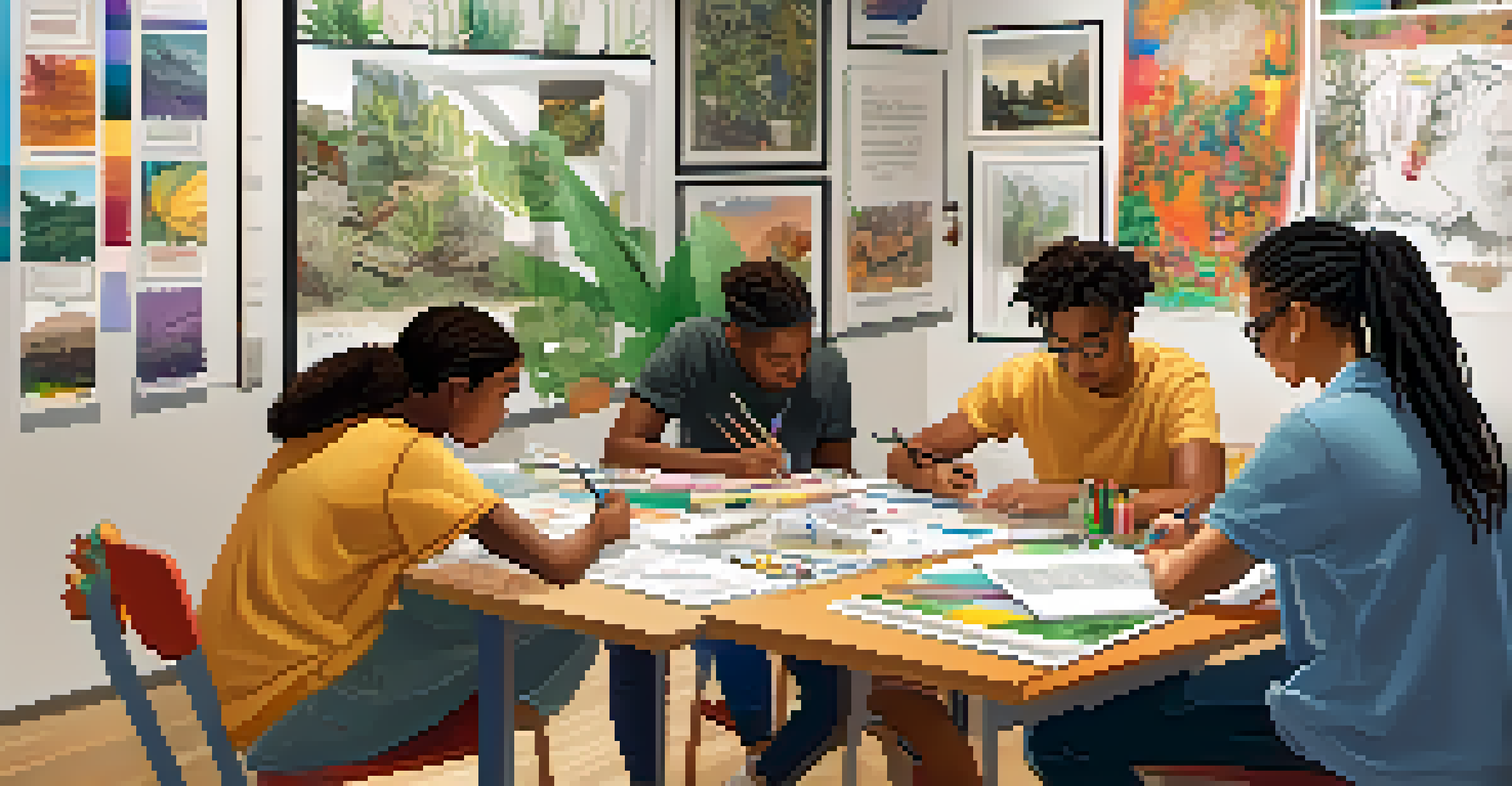Using Interdisciplinary Methods to Teach Global Issues

Understanding Interdisciplinary Teaching Approaches
Interdisciplinary teaching combines knowledge and methods from various disciplines to address complex issues. This approach encourages students to see the interconnectedness of different fields, promoting a more holistic understanding of global challenges. For instance, tackling climate change might involve insights from environmental science, economics, and ethics.
The greatest danger in times of turbulence is not the turbulence; it is to act with yesterday's logic.
By drawing from multiple perspectives, educators can create richer discussions and deeper engagement among students. It allows learners to apply concepts from one area to another, facilitating critical thinking and innovative problem-solving skills. This interconnected learning experience can be particularly valuable in today's multifaceted world.
Ultimately, interdisciplinary methods help prepare students for real-world scenarios where issues aren't confined to a single subject. This prepares them to collaborate across disciplines, which is essential for addressing the complexities of global problems.
The Importance of Global Issues in Education
Global issues like poverty, health crises, and environmental sustainability are not just topics for discussion but crucial areas for action. Educating students about these challenges equips them with the knowledge to become informed global citizens. Understanding these issues fosters empathy and a sense of responsibility towards the planet and its inhabitants.

Incorporating global issues into the curriculum encourages students to think critically about the world around them. They learn to ask questions, analyze data, and consider the impacts of various actions on a global scale. This kind of education is vital in shaping future leaders who can tackle these pressing challenges head-on.
Interdisciplinary Teaching Benefits
Interdisciplinary teaching enhances critical thinking and problem-solving skills by encouraging students to draw from various fields.
Moreover, addressing global issues helps students relate their learning to real-life scenarios, making education more relevant and engaging. When students see the impact of their studies, they are more likely to be invested in their learning journey.
Examples of Interdisciplinary Global Issues
Some pressing global issues lend themselves well to interdisciplinary study, such as climate change, which intersects environmental science, politics, and economics. For example, analyzing the economic impacts of climate policies can enhance students' understanding of both environmental and financial systems. This kind of integrated learning highlights the importance of various disciplines working together.
Education is the most powerful weapon which you can use to change the world.
Another example is global health, which requires knowledge from medicine, sociology, and public policy. Students can explore how social factors affect health outcomes, allowing them to appreciate the broader context of health crises like pandemics. This analysis can lead to more comprehensive solutions that consider various societal influences.
Interdisciplinary approaches can also be applied to issues like migration, where geography, human rights, and history intersect. By exploring these themes together, students can develop a nuanced understanding of the challenges faced by migrants and the policies that govern their experiences.
Creating an Interdisciplinary Curriculum
Developing an interdisciplinary curriculum requires collaboration among educators from different fields. Teachers can work together to design lessons that integrate their subjects around common themes or problems. This collaboration not only enriches the learning experience but also fosters a sense of community among educators.
For instance, a project on sustainable cities can involve geography, science, and art teachers working in unison. Geography might cover urban planning, science could focus on environmental impacts, and art could explore visual representations of sustainable design. This collaborative approach makes the learning process more dynamic and engaging for students.
Global Issues Shape Education
Integrating global issues into the curriculum helps students become informed citizens who understand their role in addressing complex challenges.
Additionally, integrating technology can enhance interdisciplinary learning by providing access to diverse resources and tools. Online platforms can facilitate collaboration between students from different disciplines, allowing them to share insights and ideas, further enriching the learning experience.
Challenges in Implementing Interdisciplinary Methods
While the benefits of interdisciplinary teaching are clear, there are challenges in implementation. One significant hurdle is the traditional structure of educational institutions, which often compartmentalizes subjects. Teachers may feel confined to their specific disciplines, making collaboration more difficult.
Another challenge is the varying levels of familiarity with interdisciplinary practices among educators. Some may be hesitant to step outside their comfort zones or may lack the necessary training. Overcoming these barriers requires professional development and supportive leadership that encourages a culture of collaboration.
Finally, assessing student learning in an interdisciplinary context can be complex. Educators need to develop assessment methods that reflect the integrated nature of interdisciplinary projects, ensuring that students are evaluated on their ability to synthesize information from various fields.
Benefits of Interdisciplinary Learning for Students
Interdisciplinary learning offers numerous benefits for students, including enhanced critical thinking and problem-solving skills. By engaging with diverse perspectives, students learn to approach problems from various angles and develop innovative solutions. This flexibility in thinking is invaluable in an ever-changing global landscape.
Additionally, this approach fosters better communication and collaboration skills. Students often work in teams, learning to articulate their ideas clearly and listen to others' viewpoints. These skills are essential for success in both academic and professional settings, as collaboration is increasingly important in today's workforce.
Curriculum Collaboration is Key
Creating an interdisciplinary curriculum requires collaboration among educators, enriching the learning experience for students.
Moreover, interdisciplinary learning can ignite a passion for lifelong learning. When students see the relevance of their studies to real-world issues, they are more likely to pursue knowledge beyond the classroom, cultivating a curious and engaged mindset that will serve them throughout their lives.
Conclusion: The Future of Interdisciplinary Teaching
As global issues become more complex, the need for interdisciplinary teaching is more pressing than ever. Educators must adapt their methods to prepare students for the challenges they will face in the future. By embracing interdisciplinary approaches, we can foster a generation of thinkers and problem solvers equipped to tackle the world's pressing issues.
The future of education lies in collaboration, creativity, and critical thinking across disciplines. Schools and universities that prioritize interdisciplinary methods will not only enhance student learning but also contribute to a more informed and engaged citizenry. This holistic approach to education is essential for building a sustainable future.

Ultimately, the success of interdisciplinary teaching depends on commitment from educators, institutions, and communities. By working together, we can create learning environments that inspire students to explore, question, and ultimately change the world.